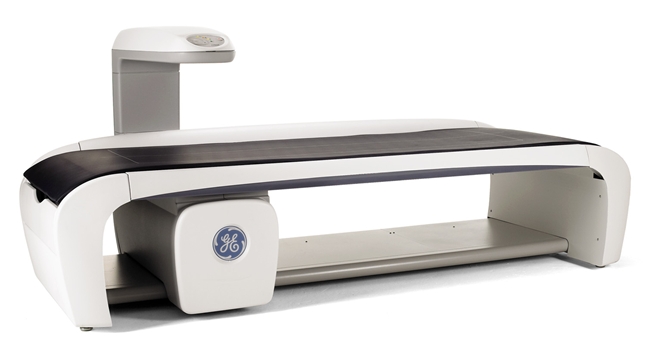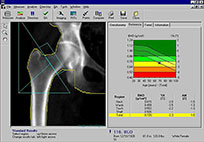Bone Density Scan

A bone density scan may be used for a variety of reasons but it is most often used to determine bone health. Particular in aging women, osteoporosis is a condition where bone health deteriorates to the point where bones easily fracture and cause severe pain.
Bone Densitometer
Rosemark Women Care Specialists has invested in state-of-the-art equipment to perform bone densitometry tests. These tests, also called dual-energy x-ray absorptiometry, DEXA, or DXA uses a very small dose of ionizing radiation to measure bone loss. The equipment produces pictures of the inside of the body, typically the lower spine and hips, to measure bone loss. The measurements are used to assess an individual’s condition and diagnose osteoporosis.
The Procedure
The DXA procedure is an enhanced form of x-ray technology that is noninvasive and typically only takes about ten minutes. The scan requires minimal preparation and may be performed with a patient wearing loose comfortable clothing. However, jewelry or any metals like a belt buckle will need to be removed. Patients need to tell their doctor and/or the DXA technician if they are pregnant even though the radiation amount is very minimal.

During the DXA procedure, the patient lies on a padded table and is made to feel comfortable. The equipment, which includes an x-ray generator, is located below the patient and situated. An imaging device that is positioned above the patient slowly passes over the target area generating images on a computer monitor.
The patient is instructed to hold very still and even hold their breath for few seconds during the scan to reduce the possibility of a blurred image.
Osteoporosis
 The DXA bone density scan is most often used at Rosemark to diagnose osteoporosis. The condition often affects women after menopause. Over time, there is a gradual loss of calcium which causes bones to become thinner and more fragile. In serious cases, frequent bone breaks occur as the bones become brittle.
The DXA bone density scan is most often used at Rosemark to diagnose osteoporosis. The condition often affects women after menopause. Over time, there is a gradual loss of calcium which causes bones to become thinner and more fragile. In serious cases, frequent bone breaks occur as the bones become brittle.
The DXA scan provides a T-Score to determine bone health. Normal bone health T-Scores are positive numbers. Negative numbers will likely yield a diagnosis of osteopenia, which is considered low bone density down to a -2.5 score. T-Scores less than -2.5 will most likely result in a diagnosis of osteoporosis.

Risk Factors
To determine the diagnosis of osteoporosis, the Rosemark obgyn doctors will use the T-Scores from the DXA scan and other test results in the diagnosis. They will also consider risk factors of osteoporosis which include:
- Female
- Caucasian
- Advanced age
- History of bone fracture
- Small thin frame
- Family history of osteoporosis
- Removal of Ovaries
- Early menopause
- Low calcium diet
- Lack of exercise
- Eating disorders
- Certain medications
- Alcohol use
- Tobacco use
With a diagnosis, the doctor will provide a treatment plan.
Summary
As a convenience to our patients, Rosemark has invested in bone density scan equipment. Our in-house equipment and services provide cost savings and saves a trip to the hospital. If you have concerns about your bone health and osteoporosis, give us a call for an appointment.
